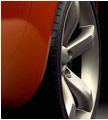U.S. Secretary of Commerce Visits Phoenix Fuel
Cell Vehicle on Earth Day
For Release: April 22, 2002
CONTACTS:
Scott Fosgard, General Motors
586.947.3295
BEIJING - U.S. Department of Commerce Sec. Donald
Evans today visited China for a demonstration of a fuel
cell vehicle developed by a vehicle engineering joint venture
of General Motors Corp. in China.
The demonstration was part of an exhibition arranged in
conjunction with Earth Day to showcase Sino-US cooperation
in the development of clean energy technology to improve
the environment in Beijing and all of China.
"Fuel cells and hydrogen-based technology represent
the future of transportation," said Tim Stratford,
Vice Chairman of the General Motors China Group. "Hydrogen
is a clean-burning and renewable source of energy whose
development has drawn the support of both the Chinese and
United States governments. ``
"There is great potential for a country like China
to adopt hydrogen as a fuel. However, this requires the
growth of a hydrogen infrastructure and the full cooperation
of government and industry through projects such as this."
The zero-emission fuel cell wagon, called the Phoenix,
is based on a Buick GL8 from Shanghai GM, GM's vehicle assembly
joint venture in China. It was unveiled last November in
Shanghai, China. PATAC (Pan Asia Automotive Technology Center),
a joint venture of GM and Shanghai Automotive Industry Corporation,
took the lead on the project, integrating the fuel cell
system into the vehicle, using a fuel cell stack developed
by GM. Scientists and engineers at GM's Global Alternative
Propulsion Center in the United States and Germany provided
the fuel cell system, components and technical support.
A portable hydrogen refueling station designed to be compatible
with hydrogen sources in China also was supplied by GM for
the Phoenix.
The fully running, eight-passenger vehicle is powered by
compressed hydrogen. Electricity, created by the fuel cell,
is stored in a battery module, which powers an electric
motor that propels the vehicle with 35 kilowatts (47 horsepower).
"The Phoenix is serving as a test bed for further
hydrogen-based research and development efforts by SAIC,
GM and our technology partners," said Stratford. "As
the
global leader in fuel cell development, GM's overriding
aim is to help China reduce its dependency on imported petroleum
while providing a cleaner and greener environment. This
is especially important to Beijing, the host of the 2008
Olympic Games."
PATAC is a 50-50 joint venture of SAIC and GM located in
Shanghai. Established in 1997, it is Asia Pacific's first
independent automotive engineering and design center joint
venture. PATAC offers a range of advanced services to its
parent companies as well as to other automotive companies
in China and across the region.
SAIC is one of China's top three automotive companies and
the country's leading sedan manufacturer. It accounts for
more than half of the country's sedan sales. In addition
to PATAC, SAIC also partners with GM in Shanghai GM, a joint
venture that produces a family of Buick products.
General Motors, the world's largest vehicle manufacturer,
designs, builds and markets cars and trucks worldwide. In
2001, GM earned $1.5 billion on sales of $177.3 billion,
excluding special items. It employs about 362,000 people
globally. GM currently has more than 3,800 employees, three
joint ventures and two wholly owned enterprises in China.




